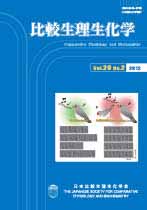All issues

Volume 29 (2012)
- Issue 4 Pages 197-
- Issue 3 Pages 112-
- Issue 2 Pages 50-
- Issue 1 Pages 3-
Predecessor
Volume 29, Issue 2
Displaying 1-4 of 4 articles from this issue
- |<
- <
- 1
- >
- >|
Review
-
Koji SATO2012Volume 29Issue 2 Pages 50-57
Published: April 30, 2012
Released on J-STAGE: May 25, 2012
JOURNAL FREE ACCESSChemosensory system recognizes more than 100,000 chemical compounds in the environment. Animals have evolved the diverse chemoreceptor gene families, which allow the recognition of infinitely many chemicals. In vertebrates, most of chemoreceptors belong to the family of G-protein coupled receptors possessing seven-transmembrane domains. Thus, binding of ligand and receptors results in activation of G-protein signaling pathways and downstream ion channels. Although insect olfactory and gustatory receptors have been reported as the member of G-protein coupled receptors, recent progress in the functional expression of insect chemoreceptors revealed the conformation of ligand-gated ion channel by olfactory and gustatory receptors. The activity of these ion channels is independent of known G-protein signaling pathways. Genome analysis of fruit flys also has revealed the diverse ionotropic glutamate receptor-related gene families function as the chemoreceptor. In this review, I discuss some of the molecular mechanism underlying the insect chemosensory systems, with a particular focus on the function of chemosensory receptor-channels.View full abstractDownload PDF (1699K) -
Satoshi KOJIMA2012Volume 29Issue 2 Pages 58-69
Published: April 30, 2012
Released on J-STAGE: May 25, 2012
JOURNAL FREE ACCESSOscine songbirds learn to produce complex vocalizations, song, by imitating their tutor’s song in early life, just as human infants learn to produce speech sounds from adults. Birds develop their song in a highly complex sensorimotor learning process, in which they try to match their own vocalizations to the memorized information of tutor song. The anterior forebrain pathway (AFP) plays a major role in this sensorimotor learning process, and recent studies regarding this pathway have revealed important mechanisms underlying song development and maintenance. Here, I present an overview of recent work on the function of the AFP including my work, and review influential models that explain how birds develop and maintain their song using the AFP. The AFP has also recently attracted great interest as a tractable model system for studying the function of basal ganglia-cortical loop circuits, because the AFP is highly homologous to mammalian basal ganglia circuits but specialized for a single task, song learning. I review recent work of the AFP on this topic, and discuss possible contributions and future challenges of songbird research in understanding basal ganglia function.View full abstractDownload PDF (2393K) -
Yasuko MANABE, Naoko GOTO-INOUE, Mayumi TAKAGI, Nobuharu L. FUJII2012Volume 29Issue 2 Pages 70-75
Published: April 30, 2012
Released on J-STAGE: May 25, 2012
JOURNAL FREE ACCESSThe AMP-activated kinase (AMPK) is an evolutionarily conserved metabolic sensor, which maintaines cellular energy homeostasis. Homologs of AMPK are found in all eukaryotic animals, sucrose nonfermenting 1(SNF1) in yeast, snf1-related kinase 1 (SnRK1) in plants, AMP-activated kinase (AAK) in worms, and AMPK in flies. AMPK is a heterotrimer consisting of α-catalitic subunit, β and γ-regulatory subunits. AMPK is activated by starvation, the depletion of energy source and some stresses followed by enhancement of energy producing catabolic reactions and suppression of energy consuming anabolic reactions. Historically, activation of AMPK was believed to be regulated by allosteric binding of AMP and ATP at γ-regulatory subunits. However, recent reports suggest that AMPK is regulated by binding of not only AMP and ATP, but also ADP.
In this review, we focused on the structure, function and regulation of AMPK in representative eukaryotic animals and also describes multiple metabolic regulations induced by AMPK activation.View full abstractDownload PDF (1604K)
Lecture note
-
Masaki SAKAI2012Volume 29Issue 2 Pages 76-86
Published: April 30, 2012
Released on J-STAGE: October 17, 2012
JOURNAL FREE ACCESS
- |<
- <
- 1
- >
- >|